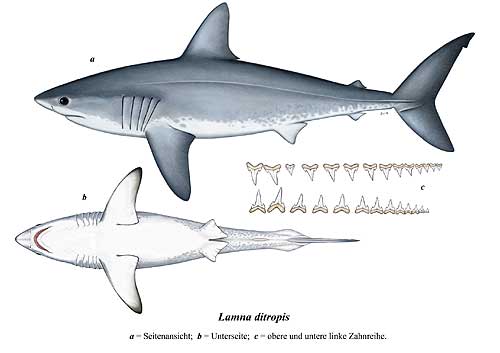
|
|
|
|
|
|
Shark Info (07-20-2002) |
Author |
|
Intro: |
Shark Info |
|
Main article: |
Shark Info |
|
Article 1: |
Shark Info |
|
Article 2: |
Shark Info |
|
Article 3: |
Shark Info |
|
Article 4: |
Shark Info |
|
Fact Sheet: |
Shark Info |
|
Fact Sheet: Salmon Shark
The biology of the salmon shark (Lamna ditropis)The biology of the salmon shark (Lamna ditropis) The salmon shark is a commonly found species which can live both in coastal and oceanic regions, preferring cool, northern waters. Like several other species from the Lamnidae family, they can maintain their body temperature with the help of a vascular net (rete mirabilis) which maintains the water temperature around their bodies. They swim both underneath the water's surface and in depths of up to 150 meters. This species is found solitary or in schools and aggregate when feeding. DescriptionThe salmon shark has a spinal-shaped, lightly bulbous body with conspicuously large gill slits and a conical snout. The first dorsal fin is very high and erect, originating just over or slightly behind the pectoral insertions. Their second dorsal fin is minute and begins just about over the beginning of the anal fin. They have strong keels on the caudal peduncle, with a secondary keel on the caudal base, and a crescent-shaped dorsal fin. ColorationThe salmon shark has a dark gray back and a white belly. The coloring changes on the sides and is marked by dark spots and blotches. The first dorsal fin is dark up to its free rear tip. Distribution
Salmon sharks are found in the northern and eastern Pacific around
Japan and Korea. Their range stretches from the Bering Strait to
southern California, and they may even venture to Baja California
and Mexico. SizeTheir average size is between 250 and 280 cm long, with a maximum size of about 300 cm. FeedingAs their name implies, salmon shark prefer to feed on Pacific salmon (from the Oncorhynchus family), but their diet also includes other bony fish. ReproductionThe salmon shark reproduces aplacental viviparously (ovoviviparous). Cannibalism in the uterus is common with this species, i.e. the embryos in the uterus eat the less developed eggs. Generally salmon shark bear up to four pups per litter. Males mature when reaching a length of approximately 180 to 240 cm. Similar SpeciesSalmon sharks could be mistaken for mackerel sharks (Lamna nasus), however, clear identification is possible by comparing the free ends of their first dorsal fins. With the salmon shark it is just as dark as the dorsal fin, with mackerel sharks it is white and shows a clear dividing line. Danger to HumansAs with other species from the Lamnidae family, salmon sharks could be potentially dangerous due to their size. EndangermentIt is not certain as to what extent the salmon shark must be considered an endangered species. However, their populations could be threatened because they are fished by Japanese longline fishermen in the northern Pacific. May be published only by indicating the source: Shark Info |
|
|
|
|
|
|||||
